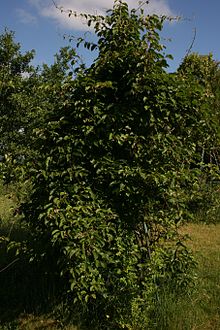Actinidia arguta
| Hardy Kiwi | |
|---|---|

| |
| Scientific classification | |
| Kingdom: | |
| (unranked): | |
| (unranked): | |
| (unranked): | |
| Order: | |
| Family: | |
| Genus: | |
| Species: | A. arguta
|
| Binomial name | |
| Actinidia arguta | |
The hardy kiwi is a vine, native to Korea, Northern China, and Russian Siberia, that produces a small fruit resembling a miniature kiwi.[1]
A small, green to purple skinned fruit similar to kiwifruit, hardy kiwifruit (also known as kiwi berry, baby kiwi, dessert kiwi or cocktail kiwi) is an edible, berry or grape-sized fruit of a Cultivar Group of the woody vine Actinidia arguta. Often sweeter than the kiwifruit, hardy kiwifruit can be eaten whole and need not be peeled. Thin-walled, its exterior is smooth and leathery, providing a deceiving contrast to the fuzzy, brown exterior of its larger sibling fruits.
Cultivation
The fast-growing, climbing vine is very hardy (hence the name), and is capable of surviving slow temperature drops to -32°C (-25°F). The vines need a frost-free growing season of about 150 days, but are not damaged by late freezes, provided that temperature changes are sufficiently gradual to allow plants to acclimate. Indeed, a period of winter chill is necessary for successful cultivation. However, rapid freezes will kill off buds and split vines. The vines can also be grown in low-chill areas.[1] The natural altitude range of plants is 200-3,600 meters (650-12000 feet) above sea level.[2]

While hardy kiwi may be grown directly from seeds (germination time is approximately one month), it is also possible to propagate from cuttings. Hardy kiwi cuttings may be grafted directly onto established kiwifruit rootstock, or rooted themselves. In natural conditions, vines will climb trees to reach heights of up to 100 feet. In domestic cultivation, a trellis may be used to encourage horizontal growth for easy maintenance and harvesting. Plants can tolerate partial shade but yields will be optimized with full sunlight.[1]
Soil should be slightly acidic (pH 5.0-6.5), as nitrogen deficiencies can appear in neutral soils. Nitrogen fertilization is encouraged during the first half of the growing season, but should be tapered off as proximity to harvest increases, as it can have deleterious effects on fruit shelf-life. Hardy kiwi vines consume large volumes of water, but must be grown in well-drained soils to prevent root rot.[1]
For vines to bear fruit, both male and female plants must be present to enable pollination. A male pollinator can enable eight female producers to fruit.[3] Flowering typically occurs in May (in the Northern Hemisphere) starting in the third year of growth.[4] For best results, fruits can be left to ripen naturally on the vine. An autumn harvest is standard among all varieties; within this, actual harvest times are highly dependent on local climate and the specific cultivar grown. The Cordifolia cultivar ripens in early September, while the Ananasnaja cultivar ripens in late October to early November (assuming growth in the Northern Hemisphere)[1] Each individual vine can produce up to 100 pounds of fruit per year.[3]
Attempts to commercialize the fruit have been historically unsuccessful due to its short shelf-life and sporadic tendencies to ripen. However, attempts are being made to bring the fruit to greater bear, and commercial production initiatives are underway on a small scale in South America, New Zealand, Europe, and the USA (in Oregon, Washington, and northern New England). Global commercial production remains under 200 hectares annually (roughly 500 acres, or 2 km²).[5]
The vines of the hardy kiwi possess a catnip-like smell which can attract cats. Cats have been known to destroy vines and dig up roots in search of the source of the scent. As such, growers should take care to protect the base of each vine with wire mesh if nuisance cats are present.[1]
Varieties

There are 3 botanical varieties:
- Actinidia arguta var. arguta
- Actinidia arguta var. giraldii
- Actinidia arguta var. purpurea
Purchasing
This section possibly contains original research. (March 2010) |
In the UK, hardy kiwifruits are available in some food outlets, including the supermarket Waitrose. In the US, they can be found at specialty food stores such as Trader Joe's, Whole Foods Market, Greenlife Grocery River Market Co-op, First Alternative Coop, Sam's Club, and Hy-Vee. Due to the short shelf-life of the fruits, supplies are typically available only in close proximity to the March and October harvests.
References
- ^ a b c d e f HARDY KIWIFRUIT Fruit Facts. 1996, California Rare Fruit Growers, Inc.
- ^ 中国高等植物数据库全库(中国种子植物部分) 2010, Institute of Microbiology, Chinese Academy of Sciences
- ^ a b Park Seed: Hardy Kiwi Park Seed: Hardy Kiwi 'Michigan State'. 2010, Park Seed Company.
- ^ Kiwifruit and Hardy Kiwi Kiwifruit and Hardy Kiwi HYG-1426-93. John Strang & Richard C. Funt, Ohio State University.
- ^ What is NZ Kiwiberry? What is NZ Kiwiberry? NZ KiwiBerry Growers Incorporated.
